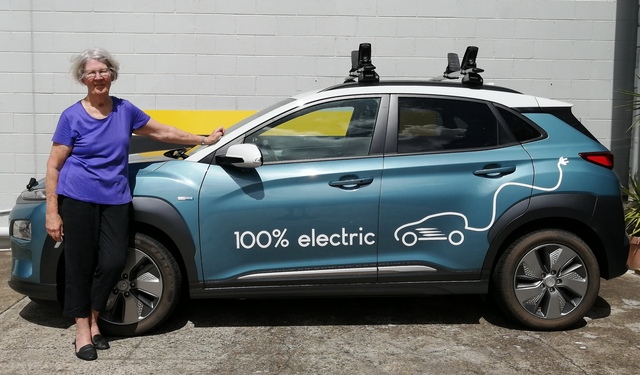The transport world is changing rapidly, with star performer Norway selling just 45 fossil-fuelled cars in the month of July as the share of full battery electric vehicles hit a record 92 per cent.
Closer to home, many Noosa locals will have seen Vivien Griffin’s distinctive, teal Hyundai Kona around our streets and close to our waterways. It’s the one with the words ‘100 per cent electric’ proudly embossed on the side and it often has her kayak strapped on top.
“I had the signage added because I wanted people to know that there were more types of EVs than just Teslas,” she said, “and to come up and ask questions.”
Compared to when Vivien bought her car, there are now more than 70 different EV models available in Australia, catering to all budgets, with another 30 on their way. There are four models available for under $40 000 (before on-road costs). For example, the GWM Ora Standard Range hatchback has now joined the under $40,000 mark – astonishing value for an EV with more than 400km range. Cost is also helped by the Queensland Government’s $6000 rebate.
Vivien notes that it’s important to do your homework on the actual range of a vehicle compared to the quoted range. “Driving conditions such as speed and whether you are using the air-con can all affect the driving range of a vehicle.”
Vivien commented that a common concern amongst prospective buyers is range anxiety but drivers can now confidently plan trips using apps such as Plugshare which maps the location, types and availability of charging stations throughout Australia.
“For example, my vehicle has a range of approximately 450 kilometres, and I did a trip to Yeppoon which is a distance of 582 kilometres. I knew I needed to charge along the trip and could easily plan ahead for a break and recharge.”
The number of charging stations has also grown rapidly. As Vivien explains, “The Queensland Government very early on set up what they called the Electric Super Highway. There are EV chargers at regular stops all along the Queensland coast. They are normally located in areas where you can go get a cup of coffee and take a pitstop break.”
In fact, the Electric Super Highway now stretches along the coast from Coolangatta to Port Douglas, and throughout the interior of the state as far out as Mt Isa, Charleville and Cunnamulla. By the end of this year, the state government will have 53 fast charging locations along the 5,386 kilometre Super Highway. This means there will be an EV charger at least every 150 kilometres. Definitely, close enough to squash any range anxiety.
The government has installed the fast chargers in convenient and safe locations easily accessible to the major highways. The locations chosen have amenities, cafes and shops so drivers can make the most of their short break.
“In Noosa, transport is estimated to contribute 30 per cent of our greenhouse gas emissions. At the end of the day, we can help reduce that figure one electric vehicle at a time. So the best thing about owning an EV is feeling good about how you are helping the planet.”
If you are interested in finding out more, visit ZEN Inc. website at zeroemissionsnoosa.com/rewiring-noosa. Here you’ll find Vivien’s video about her experience as an EV driver, other video stories about energy saving options such as home solar and home batteries to save on your energy costs, toolkits, online calculators and much more. Alternatively, contact us at info@zeroemissionsnoosa.com.







